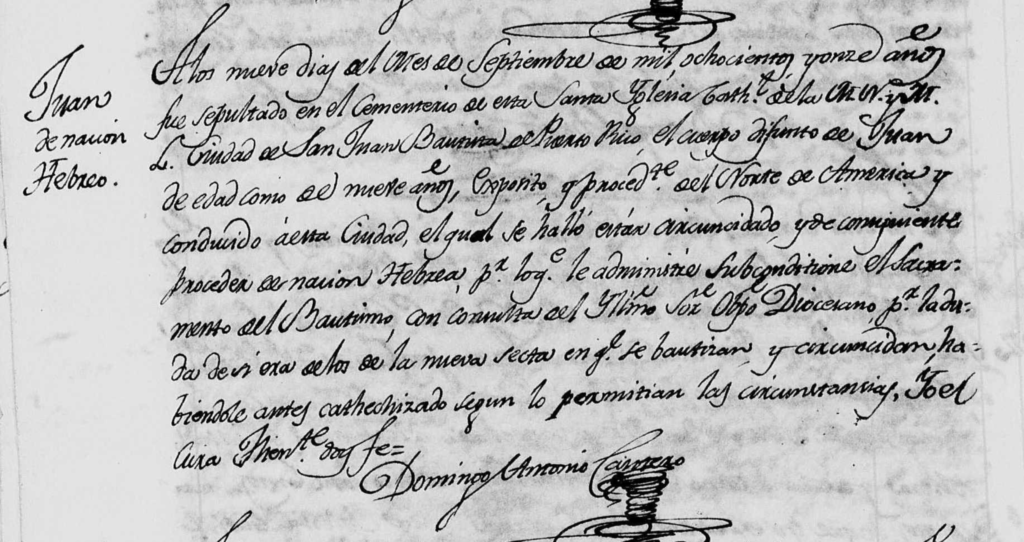Sometimes I come across documents in my research that I find interesting and so I decide to snap a photo of them to look at or analyze later. Yet, since they do not have to do with my family most of them end up in folders on my computer never to see the light of day again – mainly because I am actively researching branches on my family that require more attention and thus I forget about these random records.
However, this was an entry that I found interesting and so I decided I would share it here and analyze the document (for various reasons below). This will be a fairly short post, which I think will be nice for a change so I usually have to do a lot of digging before I write a blog post – so let’s dig in! Below is a transcription and loose translation of the above document.
Juan de nación hebrea
A los nueve días del mes de septiembre de mil ochocientos y once años fue sepultado en el cementerio de esta Santa Iglesia Católica de la M.N. y M.L. [Muy Noble y Muy Leal] Ciudad de San Juan Bautista de Puerto Rico, el cuerpo difunto de Juan de edad como de nueve años, exposito, y procediente del Norte de América y conducido a esta ciudad, el cual se halló estar circuncidado, y de consiguiente proceder de nación Hebrea, por lo que le administré sub conditione el sacramento del Bautismo, con consulta del Illmo. Sor. Obpo. [Illustrísimo Señor Obispo] Diocesano, por la duda de si era de los de la nueva secta en que se bautizan y circuncidan habiéndole antes catequizado según lo permitían las circunstancias. Yo el cura Teniente, doy fe. Domingo Antonio Cantero.
Juan of the Jewish nation
The first thing that caught my attention was the fact that Juan was listed as being of the “Jewish nation”. Yet, as you continue to read the document the death entry becomes much more interesting. Juan was a nine year old boy who was from North America and brought to Puerto Rico; however, his parents’ names were not listed because Juan was an “exposito“.
Children who were listed as exposito are children who usually were foundlings – meaning that they were abandoned at birth. Sometimes these children were adopted and took on the surname of their adopted families while others were given the surname Exposito (the word for “foundling” itself).
We do not know how much about Juan’s life was known from this death record and it is very possible that we cannot find out more. Juan had no surname, no parents’ names were listed, and we do not know where he was from in “North America”. Similarly, Juan was likely not his given name and he was given this name as he was baptized right before/when he died.
How do they know Juan was Jewish then? Well… it seems that the Domingo Antonio Cantero made this call because Juan was circumcised. He spoke to the Diocesan Bishop to confirm that Juan did not belong to the “new sect of people who baptism and circumcise”.
Religion and identity
Finding this record has led me to do some investigations around Catholicism, circumcision, and how over time this has changed. Domingo refers to the Catechism of the church which states that “amputations and mutilations on innocent people are against the moral law, unless they are for therapeutic reasons”. Similarly this act was not common in North America amongst Americans until the end of the 19th century when it became more medically common and not just an act tied to Judaism and Islam.
Still, I am not sure how they were able to make this determination based on just one physical aspect; however, I imagine in those times things were very much black and white when it came to these types of things.
It is possible that buried in the notarial records of the Archivo General de Puerto Rico there is some mention of Juan (nación hebrea); however, most of these records are not digitized and attempting research Juan without more context would be quite absurd.
Why was this interesting?
I found this record interesting for a few reasons:
- The aspect of Juan being identified as Jewish only through circumcision (per this record).
- A 9 year old North American foundling somehow ended up in the Caribbean in the 19th century.
- The intersection between Catholicism and Judaism on the island of Puerto Rico during a more “conservative” (here to read traditional) time in the world.
- The mystery of finding out more about him and the difficulty one faces when documents do not provide more information about a given person.
Again, I won’t say it’s impossible to find out more about Juan but seeing as how he was baptized before his death and likely was not always known as “Juan” throughout his childhood definitely complicates things for us.
As a genealogist, these types of situations I find totally interesting – mainly because I see them almost like logic puzzles. Trying to see what other evidence fits in to make sense of the question or the situation. This is where knowing what resources can be helpful are going to be key and instrumental in figuring out as much as possible from the puzzle.
However, there are also times where the puzzle remains just that. Until more evidence and records come along to breakdown the brick wall. My search for Juan has been fruitless so far, but I am hoping somewhere out there is more information about this little boy brought the Caribbean.
Cover Photo Source: Iglesia Católica Nuestra Señora de los Remedios (San Juan, Puerto Rico), “Defunciones, (ene.) 1811-1818 (ene.),” pg. 45v, third entry in chronological order, Juan de nación hebrea, death, 9 September 1811; accessed as “Registros parroquiales, 1645-1936,” browsable images, FamilySearch, (https://www.familysearch.org/search/catalog/1049766 : accessed 17 November 2024).

